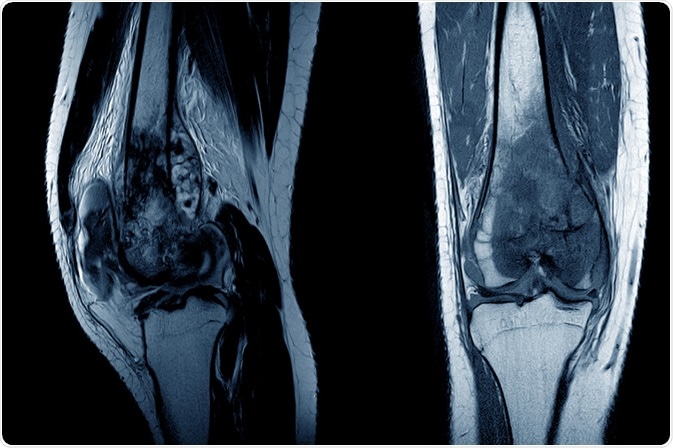The survival prognosis for people with osteosarcoma is estimated according to the severity of the tumor in the bone. It is separated into three groups: Stage I, Stage II and Stage III. Each of these will be discussed in more detail below.
 MRI of a knee joint showing osteosarcoma. Image Credit: April stock / Shutterstock.com
MRI of a knee joint showing osteosarcoma. Image Credit: April stock / Shutterstock.com
Stage I
This stage is the least common stage to occur in practice and includes parosteal and low-grade central osteosarcoma. The prognosis for individuals with Stage I is excellent at >90% with wide resection.
Stage II
This stage of tumors may differ significantly in terms of both size and the location in which they occur in the body. It includes tumors in the tibia, femur and pelvis, as well as the bones around the shoulder and in the jaw.
The prognosis of Stage II osteosarcoma varies greatly, due to the large differences that may be possible between tumors of this stage. These factors may affect the prognosis of the disease:
- Size of tumor
- Location of tumor
- Cxcr4-positive tumor
- Her2-positive tumor
- Degree of p-glycoprotein
- Time to metastases
- Degree of necrosis following chemotherapy
Pathological factors such as Cxcr4-positive, Her2-positive and p-glycoprotein are important for the prognosis as they affect the way the tumor grows and responds to treatment.
The longer the time to metastases, the better the prognosis will become. When the time is more than 12 months, a difference begins to be evident but beyond 24 months the prognosis improves significantly. However, it is still preferable to have fewer metastases than those with a longer time.
The best prognosis involves two or fewer metastatic nodules with a length of time greater than 24 months. The survival rate is approximately 50% after two years, 40% at 5 years and 20% at 10 years. The prognosis is usually worse when the metastases are both local and regional.
The degree of necrosis after treatment with neoadjuvant chemotherapy is also indicative of prognosis. The greater proportion of cell death, the better the prognosis is expected to be. Conversely, if there is a small degree of necrosis, the prognosis is likely to be lower.
Osteosarcoma | Jaliyah's Story
Stage III
This stage of osteosarcoma involves metastases in the lung. Whilst the prognosis is dependent on several factors including the number of metastases, and the respectability and degree of necrosis of the primary tumor, the prognosis is usually not very promising, with an approximate overall survival rate for this stage of 30%.
Additional information about osteosarcoma
Malignant neoplasms of the bones and joints are expected to account for a proportion of cancer deaths in children, although the amount is not known.
Mortality rates have been continuously improving with each passing year in recent times, with a 1.3% decline annually. Additionally, long-term survival rates made drastic improvements in the late 20th century and in 2009 overall survival probability was approximately 68%.
In addition to a high proportion of children being affected by osteosarcoma, there is also a second incidence peak in the elderly population. In most cases, this is associated with an underlying secondary cause. An example of this pathology is Paget’s disease of the bone.
Further Reading